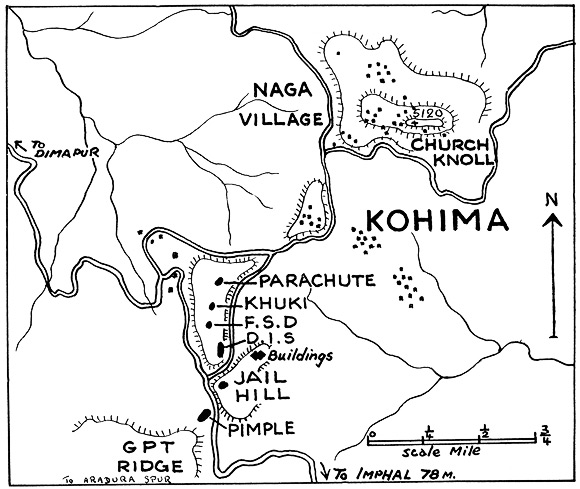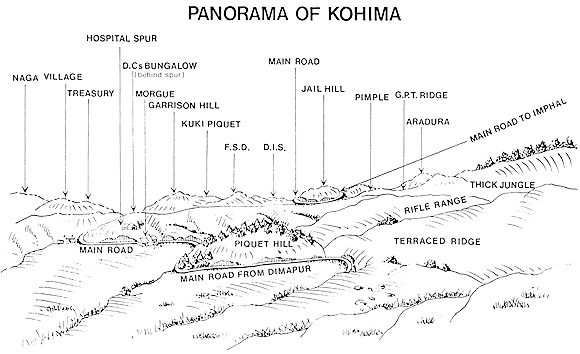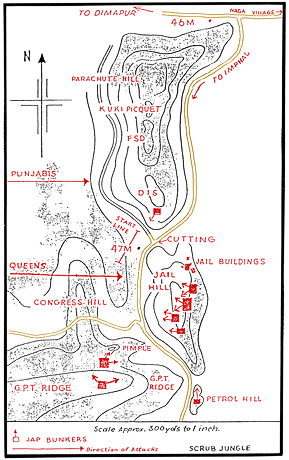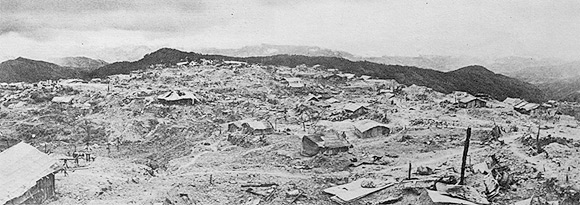The Queen's in Burma 1943-1945
The 1st Queen's In The Battles For Kohima
Chapter 3
The Situation in Kohima
The attack on Imphal and Kohima was the great Japanese offensive to destroy the Allied troops in Manipur and Assam and to open the way for the invasion of India.

The original small garrison at Kohima reinforced in the early stages by the 4th Bn The Royal West Kent Regiment, had withstood with great gallantry the Japanese attack. They fought for over a fortnight to the point of complete exhaustion until relieved by 2 British Division who had been brought from India. At one time the Royal West Kents had 250 wounded men inside this perimeter. 2 Division were now engaged in a grim struggle for command of the various features of the Kohima Ridge - in some cases sharing the hills with the enemy.

On the 6th May 1944, 1 Queen’s as part of 33 Brigade moved to Kohima, debussing at Milestone 42 and thence by stiff climb to the Rifle Range area, short of General Purpose Transport Company Ridge. They were now in the high hills about 5000 feet above sea level and it was raining, and when it rains in that part of the world there is no mistake about it. The Kohima Ridge was just like a scene from the battlefields of 1914-18. Trees had been blasted down to stumps by continuous shelling, native buildings blown to pieces and the whole area covered with shell holes filled with muddy water. Garrison Hill had scores of white parachutes dangling from stumps of trees. The garrison had been supplied by air with ammunition and water while they were fighting their hand to hand battles with the Japanese.
From the Rifle Range the Queen's could see the battleground set out before them. Kohima itself was on a line of small hills at the head of the valley. Some hundreds of feet above the Battalion position to the right the densely jungle covered Aradura Spur which fell gently down until it met the Kohima - Imphal Road just to the right of Kohima. On the Battalion's left about 1000 yards away, and about 500ft below the same road reappeared again going to Dimapur. Far away to the north across the valley the Naga village was spreadeagled across another ridge. The road from Dimapur climbed up to Kohima between Garrison Hill and the Naga village, wound left-handed round Garrison Hill then turned sharp right and ran along behind Khuki picquet and Detail Issue section Royal Indian Army service Corps Ridge. Here it suddenly turned towards the Battalion appearing in a cutting between DIS Ridge and Jail Hill, turned again and ran in front of Jail Hill and away to the Queen's right, disappearing from view where Aradura Spur came down nearly to road level. Some little way running across their front, was General purpose Transport Company Ridge - a ridge running down from Aradura Spur which fell away to the left into broken ground. Beyond that and just in front of the road was a low isolated hill nicknamed 'Pimple' .
Kohima - The First Attack on Jail Hill
On arriving in the area the Brigade came under command of 2 Division, the Commander being Major General J Grover.
Lt Colonel Duncombe received orders to attack Jail Hill the following day, 7th May. The hill was the largest feature in the central Kohima position and the key-point of the Japanese defences.
When the CO received his orders, no patrols had been made on to Jail· Hill so the strength or the location of the opposition was not known. It was, however, obvious that no attack could hope to succeed unless GPT Ridge was first cleared of Japanese. This position could completely command Jail Hill from the right rear. The Battalion attack plan was therefore contingent on GPT Ridge being cleared first.
The plan was an artillery concentration on 'Pimple', lifting on to Jail Hill: C Company to attack and capture 'Pimple' when the artillery lifted, and on securing it, D Company to pass through and attack Jail Hill when the barrage there stopped. A Company would follow up close behind and 'mop up' with B Company in reserve. Battalion Tactical Headquarters were to move to 'Pimple' after C Company and the remainder of Battalion Headquarters to await a call forward. The Battalion had a sleepless night in the pouring rain.
At 1030 hours on 7th May, GPT Ridge had not been cleared but the enemy on it were considered to be fully engaged and in no position to interfere with the Battalion. The Queen's attack on Jail Hill itself therefore went in.
C Company got on to 'pimple' without opposition, and D Company, closely followed by A Company, swept on to Jail Hill as the artillery barrage finished. Battalion Tactical Headquarters was on 'Pimple'. Although overrunning the first bunkers, D Company soon came under heavy fire from both flanks, and the assault was slowed down. Sergeant Burt, commanding one the platoons, was wounded in the arm but continued to lead his men until the bunker they were attacking was captured. When leading them on to a second bunker, he was again wounded but continued to control the attack until this second bunker was captured, but he was so badly wounded that he died.
 |
| First Battle, May 7, 1944 Second Battle, May 11 to May 14, 1944 |
At about this time 'Pimple' began to come under heavy fire both from Jail Hill area and from GPT Ridge. C Company Commander, Major G W Rothery, was wounded in the head but refused to leave and continued to command the Company. He was awarded the Military Cross for this action, in which a promising young officer, Lieutenant J Smyth was killed.
Despite the most determined efforts to clear GPT Ridge, the Japanese were in sufficient strength to command 'Pimple' and dominate Jail Hill. At about 1400 hours D Company Commander came on the wireless and reported his right hand platoon held up, the other two platoons had reached the top of the hill, but were being badly shot up. He had only fourteen men with him unwounded. It was no good re-inforcing D Company or A Company pinned down behind them, and to leave them there would lead to their annihilation. The order was given to withdraw.
The' Division's guns and the Battalion mortars did a magnificent job in smoking off the front and the flanks, and in the end-the withdrawal was successful. The men of B Company did excellent work in bringing in the wounded. It was a long carryover rough and difficult country under severe enemy fire, but many did the journey as much as five times. As a result of their efforts all the wounded were cleared from the hill. CSM Shepherd received the Military Medal for his fine work in organising and leading these parties.
Our total casualties were 1 officer and 13 men killed and 4 officers and 15 men wounded; 27 enemy were known to have been killed.
By evening the Battalion was back at the Rifle Range area bloody but unbowed.
The Second Attack on Jail Hill
The unsuccessful attack of 7th May had shown that if Jail Hill was to be captured and held, GPT Ridge had first to be cleared; and al so that DIS, Jail Hill and ‘pimple’ were interdependent and had to be attacked simultaneously.
A co-ordinated plan was therefore drawn up for the second attack on 11th May. GPT Ridge was first to be taken by another brigade, and then 1 Queen's was to capture Jail Hill at first light. The 1/1st Punjabis were to capture 'Pimple' in the dark and dig in before it was light. The 4/15th Punjabis, with a battalion of Royal Berkshires from the 2nd Division, were simultaneously to attack FSD and DIS.
The Battalion moved out at 2200 hours on 10th May for the Forming Up Place. The approach march was tiring and difficult through thick scrub with no defined tracks, and up and down hundreds of feet of steep hillside. The forming up was complete at 0315 hours with two companies forward - C on the right and B on the left. Close behind were A and D Companies.
At 0400 hours a terrific barrage opened which went on for 20 minutes. During this time our troops suffered some casualties from enemy defensive fire. At 0500 hours, with the first greyness of dawn in the sky, the troops moved forward. The first bunkers were stormed by the leading sections, firing from the hip as they went in. Then the attack, under fire from the crest and the positions beyond, became very difficult. B Company, advancing mainly by crawling, worked their way upwards towards the crest, but C Company on its right was still below on the forward slope of the hill.
By daylight it became clear that enemy bunkers still held out on GPT on the right and DIS on the left, and all movement became very dangerous. C Company Commander, Captain J H A Scott, already twice wounded, was killed directing a platoon against a Japanese bunker. His only other officer platoon commander and close friend, Lieutenant N R P Ingham, was also killed. The enemy positions were only a few yards away in some places, and at times the air was thick with grenades. CSM Buchanan of C Company was killed, and there were numerous deeds of unrecorded gallantry. Private Easton of B Company was awarded the Military Medal for his action during this time. The section of which he was in command remained for six hours under continual mortar and machine gun fire, but pinning the enemy down in one of their strongest bunker positions and protecting the company's flank.
By late afternoon on 11th May the whole of the north west part of Jail Hill was in our hands. The troops had dug in as best they could, and were ordered to hold on at all costs, but casualties were mounting. The Battalion was reinforced by two companies of 4/1st Gurkha Rifles, but one company commander was killed almost immediately.
The next day, 12th May, some tanks got through to support the attackers. Some of the positions they pounded were only 15 yards in front of our forward troops, and they succeeded in destroying two bunkers. One large bunker was holding out very obstinately, and a company of Gurkhas put in a brilliant attack and managed. to surround it. Fighting continued all day, and Major M L Mansel, A Company Commander, was mortally wounded. Towards evening things became a little easier.
At dawn on 13th May, patrols found the enemy had gone. Twenty bunkers, all recently occupied, were found on the hill. The main one, which had held 40 to 50 Japanese, had been skillfully concealed and fortified with steel shutters that could be closed against grenades. The whole hill was occupied and consolidated. The Battalion remained on Jail Hill throughout the day. It was a loathsome place, battered, barren, scattered with debris and thick with the most disgusting flies.
The 4/15th Punjabis were in possession of DIS. They, and all other units in the Kohima battle, had had similar experiences to those of the Queen's. On 14th May the Battalion was relieved by a Punjab battalion, and returned to their Rifle Range area, where they remained for the next week. Their total casual ties in the two attached had been 4 officers and 57 other Ranks killed and 6 officers and 106 men wounded. These were heavy losses, but the capture of Jail Hill was the decisive action of the Battle of Kohima and one of the most gallant episodes in the whole campaign.
In the words of one Queen's officer, 'The Jail Hill position was indeed a tough nut to crack. It was cracked by the combined efforts of British and Gurkha troops detailed for the job. The, action proved conclusively the great value of the mutual friendship and spirit of liaison between the two units immediately involved, 1st Queen's and 4/1st Gurkha Rifles.'
By 22nd May the centre of Kohima had been cleared, but the Japanese continued to fight doggedly in Naga village on the left flank and Aradura Spur on the right. On this day 33 Brigade took over the Naga village area from a brigade of the 2nd Division. The Queen's were in the south east of the perimeter, with 4/15th Punjabis on their left and the 4/1st Gurkhas on the right. The Japanese positions were about 100 yards away, and conditions resembled those of trench warfare in the 1914-18 War.

The Naga Village.
On the evening of 26th Mayan enemy attack in strength against the Brigade position was repulsed. Intermittent fighting continued throughout the 30th and 31st May. On the Glorious First of June, their last day in the line, the Queen's supported by tanks, captured the long contested stronghold of Naga village. The Battalion was then withdrawn to Dimapur to rest and refit.
Related
